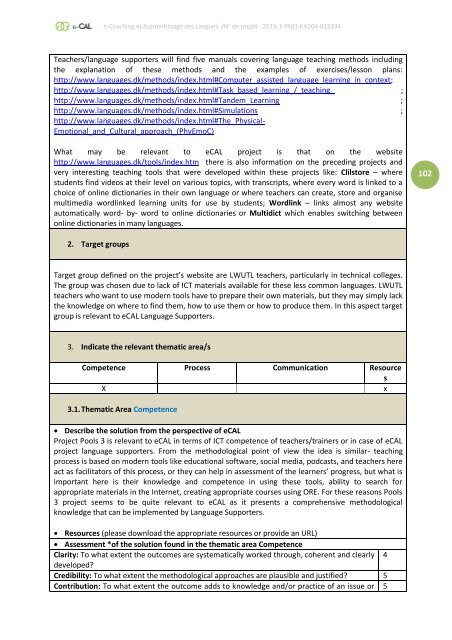e-CAL - e-Coaching et Apprentissage des Langues
The ERASMUS+ project e-CAL presents the result of an analysis of support methods in the case of language learning using web-based Open Educational Resources (OER).
The ERASMUS+ project e-CAL presents the result of an analysis of support methods in the case of language learning using web-based Open Educational Resources (OER).
You also want an ePaper? Increase the reach of your titles
YUMPU automatically turns print PDFs into web optimized ePapers that Google loves.
e-<strong>Coaching</strong> <strong>et</strong> <strong>Apprentissage</strong> <strong>des</strong> <strong>Langues</strong> /N° de proj<strong>et</strong> : 2015-1-FR01-KA204-015334<br />
Teachers/language supporters will find five manuals covering language teaching m<strong>et</strong>hods including<br />
the explanation of these m<strong>et</strong>hods and the examples of exercises/lesson plans:<br />
http://www.languages.dk/m<strong>et</strong>hods/index.html#Computer_assisted_language_learning_in_context;<br />
http://www.languages.dk/m<strong>et</strong>hods/index.html#Task_based_learning_/_teaching_ ;<br />
http://www.languages.dk/m<strong>et</strong>hods/index.html#Tandem_Learning ;<br />
http://www.languages.dk/m<strong>et</strong>hods/index.html#Simulations ;<br />
http://www.languages.dk/m<strong>et</strong>hods/index.html#The_Physical-<br />
Emotional_and_Cultural_approach_(PhyEmoC)<br />
What may be relevant to e<strong>CAL</strong> project is that on the website<br />
http://www.languages.dk/tools/index.htm there is also information on the preceding projects and<br />
very interesting teaching tools that were developed within these projects like: Clilstore – where<br />
students find videos at their level on various topics, with transcripts, where every word is linked to a<br />
choice of online dictionaries in their own language or where teachers can create, store and organise<br />
multimedia wordlinked learning units for use by students; Wordlink – links almost any website<br />
automatically word- by- word to online dictionaries or Multidict which enables switching b<strong>et</strong>ween<br />
online dictionaries in many languages.<br />
102<br />
2. Targ<strong>et</strong> groups<br />
Targ<strong>et</strong> group defined on the project’s website are LWUTL teachers, particularly in technical colleges.<br />
The group was chosen due to lack of ICT materials available for these less common languages. LWUTL<br />
teachers who want to use modern tools have to prepare their own materials, but they may simply lack<br />
the knowledge on where to find them, how to use them or how to produce them. In this aspect targ<strong>et</strong><br />
group is relevant to e<strong>CAL</strong> Language Supporters.<br />
3. Indicate the relevant thematic area/s<br />
Comp<strong>et</strong>ence Process Communication Resource<br />
s<br />
X<br />
x<br />
3.1. Thematic Area Comp<strong>et</strong>ence<br />
Describe the solution from the perspective of e<strong>CAL</strong><br />
Project Pools 3 is relevant to e<strong>CAL</strong> in terms of ICT comp<strong>et</strong>ence of teachers/trainers or in case of e<strong>CAL</strong><br />
project language supporters. From the m<strong>et</strong>hodological point of view the idea is similar- teaching<br />
process is based on modern tools like educational software, social media, podcasts, and teachers here<br />
act as facilitators of this process, or they can help in assessment of the learners’ progress, but what is<br />
important here is their knowledge and comp<strong>et</strong>ence in using these tools, ability to search for<br />
appropriate materials in the Intern<strong>et</strong>, creating appropriate courses using ORE. For these reasons Pools<br />
3 project seems to be quite relevant to e<strong>CAL</strong> as it presents a comprehensive m<strong>et</strong>hodological<br />
knowledge that can be implemented by Language Supporters.<br />
Resources (please download the appropriate resources or provide an URL)<br />
Assessment *of the solution found in the thematic area Comp<strong>et</strong>ence<br />
Clarity: To what extent the outcomes are systematically worked through, coherent and clearly 4<br />
developed?<br />
Credibility: To what extent the m<strong>et</strong>hodological approaches are plausible and justified? 5<br />
Contribution: To what extent the outcome adds to knowledge and/or practice of an issue or 5


